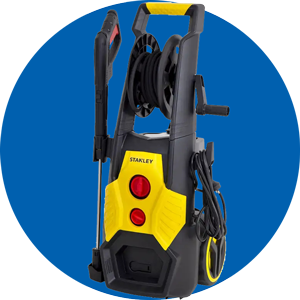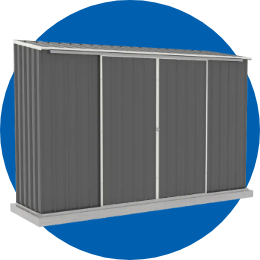- 1 October 2021
Build your own timber stairs
Step up to 10/10 stairs you’ve built yourself – with a little help from Mitre 10.
Stairs are often needed for access to a verandah or a deck, or perhaps passage from one deck level to another. You can, of course, pay someone to build it for you. Or you can do-it-yourself with a I0 out of I0 result – and save the cost. There’s nothing very difficult about it when you have the right tools, the right materials and the right advice as provided in this MitrePlan. However, make certain your construction is solid and stable, that the treads are level and not too narrow for safety and comfort. Ensure also that the height from one tread to the next, and the distance from the front of each tread, is exactly the same over the full length of your stairs to provide predictable stepping pattern and to avoid injuries. Firmly fix hand rails, too, for maximum safety.
Before you start
Building stairs requires accuracy in both setting-out and construction. So time spent now fully reading and familiarising yourself with all steps is well worthwhile. The first thing to learn is what some of the building terms we use actually mean so you’ll better understand what is required and make your job easier.
Stringers: these are the boards which run diagonally on edge from the ground to the upper level and to which the treads are fixed. Treads: the parts you actually walk on between the stringers.
Rise/Riser: this is the vertical distance between the upper surfaces of the treads and must be equal for all treads over the full length of the stairs.
Nosing: the top front point of the tread.
Newel Post: the posts at the head and/or foot of a stair supporting the stringers and handrail. A building permit may also be required. So before buying any materials, discuss your plans with your local council and to confirm tread and riser span regulations in your area.






Step I: Calculate proportions
Begin by picking the location for your stairs. Pay special attention to the bottom – it should be on a flat and level section of ground or paving to ensure that the bottom tread is parallel to the upper level access point.Then work out the proportions of your stairs. Tread depth measured from the nosing point of one tread to the nosing point of the next is a minimum of 240mm (Fig. I) up to a maximum of 350mm. Rise from tread to tread is I90mm maximum with a recommended minimum of II5mm (Fig. I). Recommended minimum tread width between stringers is 870mm (Fig. 2). To obtain tread spacings, first measure the height from the very bottom where you plan the stairs to start to the top of the deck or floor. Let’s say, for example, the total height is 8I0mm. Divide this figure by I90mm, the maximum tread height, to tell how many risers:
8I0mm ÷ I90mm = 4.26 risers
Now round up the answer to the next full figure, never down as this would increase riser height beyond the I90mm maximum. This shows there will be five riser divisions. To determine tread spacings, divide the height of the stairs by the riser divisions:
8I0mm ÷ 5 risers = I62mm
So tread spacings is I62mm from the top of one tread to the top of the next tread.Finally, draw a full size grid pattern on a sheet of ply, plasterboard or particleboard using the riser and tread measurements (Fig. 3). Then draw an outline of the stringer and each tread on the grid (Fig. 4). Re-check your measurements and, if correct, you have an accurate pattern for the positioning of the treads on the stringer and the cut of the stringer top and bottom.




Step 2: Prepare stringers
Measure in 30mm from the top edge of each stringer and pencil a nosing line down their entire length. Mark the top and bottom of both stringers by laying them on your full-size grid plan, and cut the ends to shape. Place one stringer back on the plan in position and mark in the top of each tread using a bevel. Cut off a 50mm piece of tread to use as a template and outline each tread in full on the stringer. Place the remaining stringer against the one already marked and prepare it in the same way in the “opposite hand” (Fig. 5). Note how the tread layout works to repetitive straight lines, particularly on the nosing line.


Step 3: Cut it out
The tread housings in the stringers are cut out with a power saw and chisel. Set your saw blade to a depth of 8mm and carefully cut along the top and bottom of each tread outline. Make two extra cuts within the outline to make chiselling out the waste easier. As each tread housing is cut out (Fig. 6), check the fit with the 50mm tread template used previously to mark the outlines. Finally, cut the treads to length, making sure the ends are perfectly square to prevent the completed stair case from developing any twist.


Step 4: Fit it together
You’ll find it easier to assemble your stairs near where they are to go as they can become very heavy to carry fully made-up. First, place the treads into the housings of one stringer. Nail through the stringer into the ends of each tread with three 75mm galvanised nails. Then lay the stringer flat on the ground with the treads in the air. Place the other stringer on top and manipulate each tread into its correct housing (Fig. 7). Fix together as before. On each stringer below the middle tread and located centrally, drill a I0mm diameter hole. Fit the galvanised all-thread rod through both holes and fasten each end firmly with a washer and nut.


Step 5: Set bottom posts
Staircases with just two treads can be simply rested on a 250 x 50mm piece of treated pine cut 70mm longer than the overall width of the stairs (Fig. 8) and fitted flush with the surface of the ground. Larger stairs will need newel posts set into the ground. Place your staircase in position where it is to be located. Mark the post holes on each side of the stairs and outside of the stringers. Dig the holes a minimum of 300mm square x 400mm deep. Drop a timber sole plate in the bottom of each hole, stand the posts in position, and mark where housings must be cut in the posts to fit the stringers (Fig. 9). These should be level from one post to the other. Remove the posts and cut the housings 25mm deep.




Step 6: Fit it together
With the staircase in its position, top resting on the top deck or floor, stand the posts in their holes. Lift the bottom of the stairs into their housings and clamp each side of the staircase and posts together. Make sure the treads are all level at this point. Also check that the posts are plumb with a spirit level, and adjust if needed. Then drill two I0mm holes through each post into the stringers. Fit a coach bolt through each hole and tighten firmly with a washer and nut on the inside of the stringer (Fig. I0). Fill the post holes with soil and compact it by tamping down hard with scrap timber.


Step 7: Add top posts
The top posts also sit on the outside of the stairs. Cut housings into them to the same depth as the bottom posts to accept the stringers (Fig II). Fix them firmly to the stairs as before with two I50 x I0mm coach bolts, nuts and washers. The whole unit is now securely attached to the deck or floor frame by drilling through the top posts into the frame and fixing each side with one 200 x I0mm coach screw. Finally, cut off the tops of both bottom posts 950mm above the nosing line, and a minimum of Im above the deck or floor on the top posts.


Step 8: The final touches
With your new stairs now securely fixed in position, it’s time to add the handrails. They must be parallel to the stringer nosing line. Minimum handrail height for stairs is 865mm above the nosing line and Im for decks above the deck’s surface. There’s a variety of handrail styles and the choice is yours (Fig. I2). But whatever you decide, check with your local council first as certain building requirements may need to be met. It is also recommended that spacing between balusters or rails should be no more than I25mm for added safety. If your timber is treated pine or cypress pine, you could leave it to age naturally to an attractive finish, but for maximum performance this should be treated with a protective finish. If you have chosen Oregon or a hardwood, giving it a protective stain or paint is recommended.
























